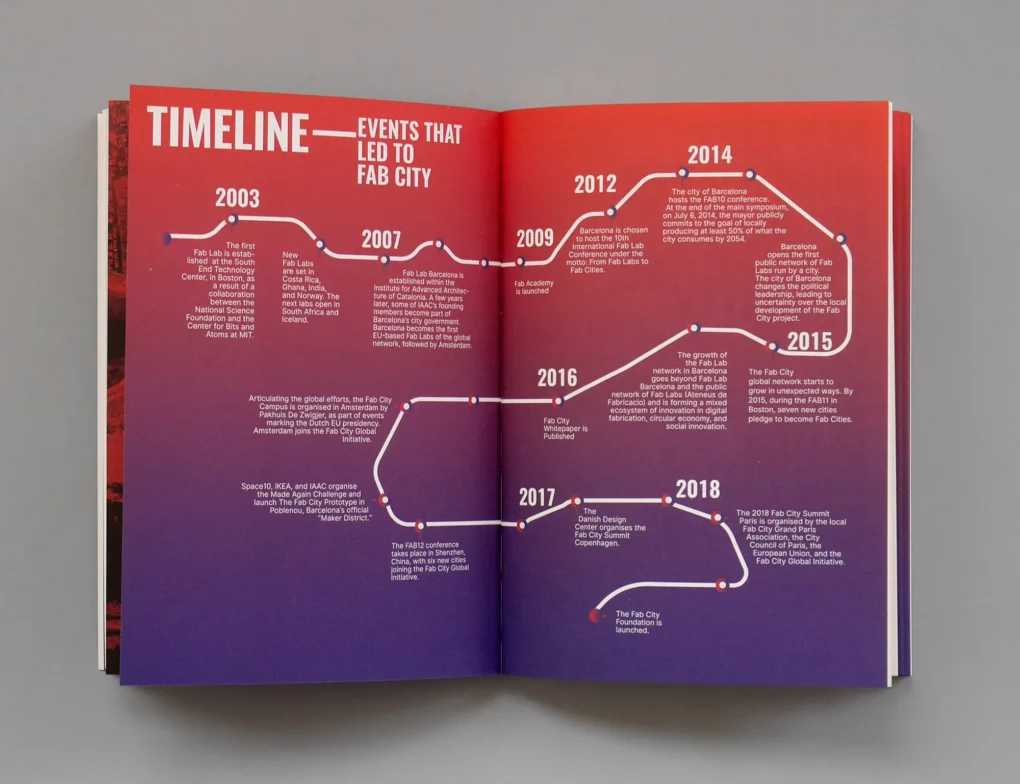Fab Labs to Fab Cities: the emergence of the Fab City Concept
Welcome to the chapter 1 of the Roadmap Saga!
In this chapter, we will take you back in time to the Awareness Era between 2011 and 2014, that gave rise to concepts and ideas that continue to guide our work today.
We will dive in the early collaboration between IAAC, CBA, MIT and the city of Barcelona and we will look back to two defining moments that further established the Fab City idea: The Fab7 in Lima and the Fab10 in Barcelona.
The Fab City concept has evolved over the years, and its early development from 2011 to 2014 laid the groundwork for its current vision and goals. It is noteworthy to see how the collaboration of several stakeholders has resulted in the wide recognition of the Fab City idea which now influences localities to achieve societal goals such as sustainability, equity, and community empowerment.

The origins of the Fab City idea
“Fab City is the whole idea that emerged from this very strong collaboration that the City of Barcelona, Institute for Advanced Architecture of Catania (IAAC) and the Centre for Bits and Atoms, MIT have had for some years.” – Tomas Diez, Executive Director of the Fab City Foundation
The Fab City idea is a demonstration of the potential of digital fabrication technologies to transform urban economies, reduce environmental impact, and improve quality of life for citizens.
The Fab Lab Network is a platform for knowledge sharing and collaboration between Fab Lab practitioners and digital fabrication enthusiasts. Fab Lab Barcelona was one of the first Fab Labs in the world. Since its establishment in 2007, Fab Lab Barcelona has played an important role within the Fab Lab Network of promoting technology and machines as instruments for transforming societies and changing the production models of cities.
The idea to scale up the impact of Fab Labs beyond making for fun to transforming cities became a shared objective of Vicente Guallart, one of the founders of IAAC, Neil Gershenfeld, director of the Center for Bits and Atoms at MIT and Tomas Diez, an urbanist, founding member of Fab Lab Barcelona and Fab City as a whole.
They started to organise this idea that took shape when the Mayor of Barcelona, Xavier Trias, the Deputy Mayor Antoni Vives, and a team from IAAC visited MIT’s CBA in 2011. This meeting further strengthened the collaboration between MIT, IAAC and the City of Barcelona. In the “Fab City Book 2018: The Mass Distribution of (almost) Everything”, Neil Gershenfeld narrates the series of events including the meeting with the mayor that led to the initiative to set up Fab Labs in the city of Barcelona based on the goal of using digital fabrication to move the city from a Products-In-Trash-Out to a Data-In-Data-Out model — under which digital bits of information travel globally, while physical atoms remain local.
Two defining moments
The first key moment was a public announcement of the Fab City idea in 2011 during Fab7 in Lima.
“The idea of building a Fab City arose during the FAB7 in Lima in 2011. At the time, the government of Barcelona had just been elected and a part of the team had followed us to Lima, including Toni Vives, the deputy mayor of Barcelona. With them, we presented the concept of the Fab City, i.e. a city where citizens could have access to a new array of infrastructures, including public fablabs with close ties to private initiatives.” – Carine Claude on Makery.info.

Fab7 Conference (2011): The Fab7 Conference was held in Lima, Peru, in 2011, and focused on the theme “Fabricating Sustainability.” The conference included workshops, talks, and exhibitions related to sustainable design and digital fabrication.
And the other was a public declaration in 2014 to start the Fab City challenge during the 10th Fab Lab Conference in Barcelona named “From Fab Labs to Fab Cities”. This moment changed the outlook of Fab Labs from existing to do technology to transforming cities.

Fab10 Conference (2014): “The City of Barcelona hosts the Fab10 Conference. At the end of the main symposium, on July 6, 2014, the mayor publicly commits to the goal of locally producing at least 50% of what the city consumes by 2054.” – 2018 Fab City Book.
Overall, the early developments of the Fab City concept from 2011 to 2014 involved a diverse group of stakeholders including Fab Labs, cities, universities and research institutions, and individuals. These stakeholders worked together to develop the foundations and resources to establish the Fab City network globally.
The outcomes from these early developments continue to play an important role in guiding the ongoing development of the Fab City initiative and are an indication of the effectiveness of collaboration between communities in promoting sustainable cities and building global networks.
A sneak peek at the next chapter…
Outputs from the initial developments of the Fab City concept
After the early developments of the Fab City idea, the Fab City White Paper was published in 2016. It outlines the vision and goals of Fab City, the strategies to implement the Fab City challenge and the benefits Fab City presents to communities. It calls for cities to shift from a model of centralised production and consumption to a model of distributed production and self-sufficiency, enabled by digital fabrication technologies.



